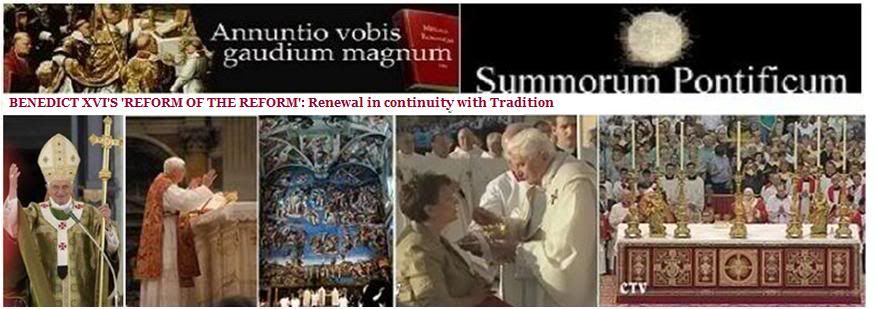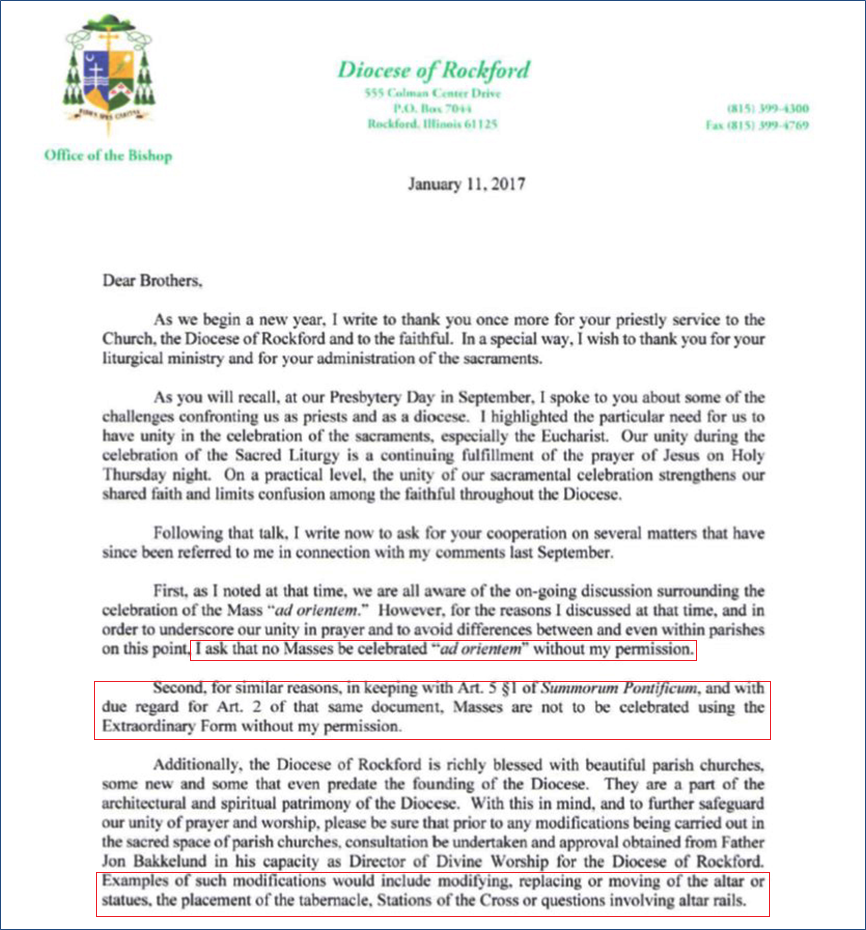 It seems there are bishops in the era of the Bergoglio pontificate who are just as intent as tearing down the brick-by-brick progress made in revitalizing the Extraordinary Form as the hundreds of priests around the world responsible for that progress ten years after SP was promulgated...
An Illinois bishop 'repeals' Summorum Pontificum
It seems there are bishops in the era of the Bergoglio pontificate who are just as intent as tearing down the brick-by-brick progress made in revitalizing the Extraordinary Form as the hundreds of priests around the world responsible for that progress ten years after SP was promulgated...
An Illinois bishop 'repeals' Summorum Pontificum
By Joseph Shaw

January 20, 2017
Bishop Malloy of Rockford, which is in Illinois in the USA, has sent a rather remarkable letter to his priests. Rorate Caeli received a copy on 16th January, and it is reproduced in full here.

The citation of Summorum Pontificum is truly astonishing: it refers to sections which state that,
to celebrate the Traditional Mass, 'a priest does not need permission, neither from the Apostolic See nor from his Ordinary' (Art. 2), and that
priests should 'willingly' (libenter) accept requests from groups to celebrate the Traditional Mass (Art 5 §1).
Having referred to these sections, Bishop Malloy then contradicts them: priests do need his permission, and they should not willingly receive requests to celebrate the ancient Mass.
Perhaps Bishop Malloy should point to another part of Art. 5 §1:
Let him [the priest] see to it that the good of these faithful be harmoniously brought into accord with the ordinary pastoral care of the parish, under the governance of the Bishop according to canon 392, by avoiding discord and by fostering the unity of the whole Church.
However, it is obvious that this is not intended to contradict the earlier statement that priests don't need permission to celebrate the Traditional Mass; rather,
it is intended to govern the way that they go about doing so: Parish priests should set up celebrations of the Old Mass in a way which harmonises with the parish's pastoral care, avoids discord and fosters unity with the Bishop.
The whole point of Summorum Pontificum is that there is no need to imagine that there should be any problems of discord, if priests are both generous and sensible. Pope Benedict makes this point with particular force in the Letter to Bishops which accompanied the Motu Proprio: addressing this 'fear', he remarks: 'This fear also strikes me as quite unfounded. '
Bishop Malloy, however, appears to be arguing that there is a danger to the unity of the diocese not from any unreasonable behaviour from priests who support the Traditional Mass, but merely from the fact that it is different from the Novus Ordo. The idea that disunity derives inevitably from liturgical differences also lies behind the ban on celebration of Mass ad orientem. This is not just contrary to the entire purpose of Summorum Pontificum, but to the clear teaching of the Second Vatican Council:
in faithful obedience to tradition, the sacred Council declares that holy Mother Church holds all lawfully acknowledged rites to be of equal right and dignity; that she wishes to preserve them in the future and to foster them in every way. (Sacrosanctum Concilium 4)
Even in the liturgy, the Church has no wish to impose a rigid uniformity in matters which do not implicate the faith or the good of the whole community.
(Sacrosanctum Concilium 37)
It is also contrary to the whole tenor of the 1970 Missal, which, as has often been pointed out, is a Missal of options. [A great example of why, in matters of the faith, there should be no doctrinal 'options' - 'Let your Yes mean Yes and your No mean No' - as there ought to be few options, if any, in the practice of the faith: the chaos of AL (which strikingly implies 'options' in very fundamental doctrines by making 'options' possible regarding admission to communion). I did not realize that Paul VI provided so many 'options' in the Novus Ordo - no wonder its champions immediately went overboard multiplying those options to the point of 'do as you please' with the Novus Ordo Mass.]
I wonder if any two celebrations of the Novus Ordo in the Diocese of Rockford on a given Sunday use exactly the same texts and ceremonies.
- There are, after all, multiple options for the Eucharistic Prayer, the acclamations, and sometimes for the readings.
- Parts or all can be celebrated in Latin, or indeed Spanish, Polish, or any other of scores of languages.
- The Penitential Rite can be replaced by the Asperges.
- The Sign of Peace and the Offertory Procession can be included or omitted.
- The Offertory prayers can be said silently or aloud.
- The proper chants can be replaced with banal and perhaps heretical 'any suitable' vernacular hymn.
- In a number of places the priest is invited to extemporise. Examples could be multiplied indefinitely.
If all the priests of Rockford do all use the same options, if they all stick to the same tried and tested texts and hymns, this is not a sign of unity: it is a sign of laziness, of a failure to explore the richness of the Paul VI Missal.
[I take it Joseph Shaw approves of these options, which I find strange in someone who is chairman of the Latin Mass Society. He calls these options 'richness', I call it chaos.
1. If too many 'options' are allowed, it amounts to virtually granting a license to do whatever pleases the priest, because yes, he will be lazy to see exactly what options are allowed, and he simply will say, 'OK, since the Missal allows options, I'm going to take the options I please'. Which seems to me exactly how all the liturgical abuses of the NO came to become routine (though subject at any time to innovation) in many parishes and dioceses.
2. Liturgy, which is by definition "formal ritual enacted by those who understand themselves to be participating in a divine action", should follow definite rules precisely because it is a 'formal ritual': formal means 'not informal', and ritual means "a sequence of activities involving gestures, words, and objects, performed in a sequestered place, and performed according to set sequence".
So, one may have a choice of liturgy, as we do in the Catholic Church - e.g., the NO, the EF, the Dominican, Mozarabic and various Eastern rites - but if I am not mistaken, except for the NO, all the other forms have remained substantially the same for centuries, and only the NO allows so many options which do not even allow it to be called a 'ritual', much less liturgy. If it is celebrated in a straightforward manner - Benedict XVI's Masses are a model for the NO - then the NO is liturgy. If it is celebrated any other way, i.e., too many options, authorized or not, it no longer deserves being called liturgy: it devolves into an informal rite (a ceremony) - not ritual - celebrated as it pleases the celebrant.][/com]
At least, that is what liberal liturgical theorists will tell us, and it must be admitted that all those options must have been included for some reason. Did all those trees die in vain?
It does not appear that Bishop Malloy is concerned, at present, to stop his priests celebrating the Mass in a variety of languages, using a variety of Eucharistic Prayers and however many other options. Perhaps he is picking his battles and intends to write another letter insisting on the use of EP II and Acclamation IV.
The canonical advice I have received indicates that his power to forbid celebration ad orientem is 'arguable', though it should be noted that Catholic churches are not guaranteed to have sanctuaries set up for celebration versus populum.
[All this was covered amply in the debate that followed Cardinal Sarah's recommendation last year to all his fellow bishops to start having the NO performed ad orientem. In short, there was never any explicit rule ordering the versus populum altars to be installed and used in place of the traditional altars in churches, even if, as a consequence of NO abuse, many churches around the world tore down those traditional altars.]
The idea that Bishop Malloy has the right to repeal Summorum Pontificum for his diocese is simply wrong. There is no way a bishop can reverse the solemn legislation of the Supreme Pontiff.
To cheer up Bishop Malloy's flock, however, he has very kindly uploaded a video of himself taking part in 'car pool kareoke'. Party on!
For more on the Church's teaching on liturgical diversity, see the FIUV Position Paper on Liturgical Pluralism.
http://www.unavoce.ru/pdf/FIUV_PP/FIUV_PP6_PluralismFinal.pdf
For more on the legal and theological status of celebration ad orientem, see the FIUV Position Paper on Liturgical Orientation
http://www.unavoce.ru/pdf/FIUV_PP/FIUV_PP4_OrientationFinal.pdf
Postscript: A reader in the USA has pointed out to me that Bishop Malloy is not entirely unfriendly to the Traditional Mass. The Institute of Christ the King Sovereign Priest has an apostolate in his diocese, and their website shows him visiting them, and assisting at the Traditional Mass in choro, on 9th August 2015 (scroll down). This does not solve the problems in his letter, of course, but may put them into a little more context. [What context? That he was merely being courteous to the Christ the King apostolate in his diocese? That he, in fact, probably had them ask his formal permission before celebrating the EF - as they habitually do elsewhere - in his diocese?
No, it is more likely that he 'welcomed' the apostolate to his diocese before Bergoglio, and that, seeing the aversion that the new pope has for the EF, Malloy has since decided it is more prudent for him to line up with the pope.]
[Modificato da TERESA BENEDETTA 21/01/2017 20:11]